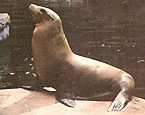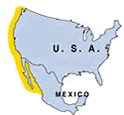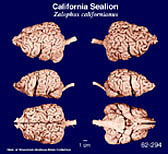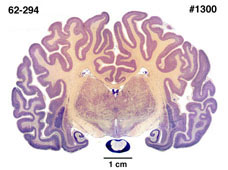|
California
Sealion
(Zalophus californianus) #62-294 |
||||
|
|
Physical
characteristics and distribution
|
|
California Sea Lions have a chocolate brown coat with a few lighter spots. Males have a highly noticeable main while females do not have a main at all. Adult males are 200-250 cm long and weigh 200-400 kg. Adult females are 150-200 cm long and weigh 50-110 kg. They feed on a wide variety of seafood including fish, shellfish and squid. They are excellent predators with a streamlined body and highly sensitive whiskers to detect food. They
also have a wide range of vocal sounds. These are cautious
animals, they will jump in the water at anything strange
or if they sense danger. California Sea Lions walk slow,
but they swim very fast and agile. Males become territorial
between May and June, guarding harems of about 15 females
each. The females usually breed around May to June and have
a 12 month gestation period. The pup is usually born from
June to August in land or water. There habitat is in coastal waters and rocky coastlines. Being an essentially coastal animal, there are found no more than 16 km out to sea. They can be found on the Northern Pacific coastal regions of Canada (British Columbia), Mexico (Baja California, and throughout the Gulf of California), USA (Washington, Oregon, California). |
|
Description
of the brain
|
|
Animal
source and preparation
|
|
All
specimens collected followed the same preparation
and histological procedure.
|
Other Related Resources (websites and publications)
List of Specimens | Explore Collections | Brain Sections | Brain Evolution | Brain Development | Brain Circuitry | Brain Functions | Location and Use | Related Web Sites | Contact Us | Search MSU Database | Personnel | Home



